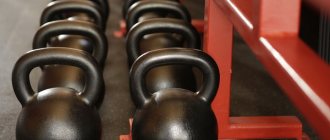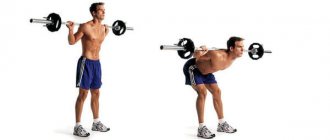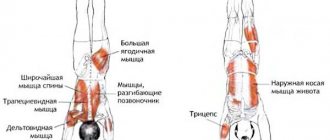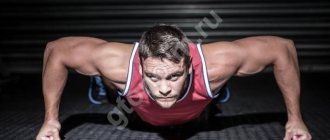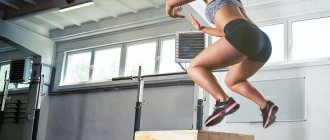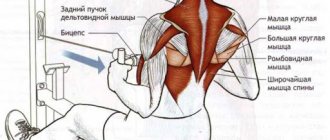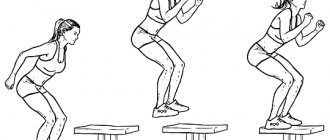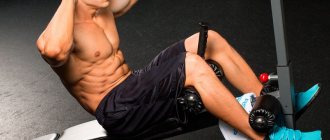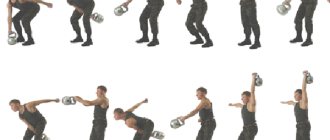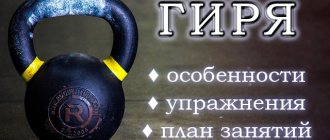Muscular arms are the pride of every man.
To get your body in ideal shape, you need to exercise regularly and spend at least several dozen hours a week on training.
However, before the practical part of improving your body, you need to thoroughly know the theory so as not to overload your muscles, avoid getting injured, and learn how to work with sports equipment correctly.
So, biceps training with dumbbells and kettlebells is very effective. How to pump up your biceps with kettlebells will be discussed in this article.
Standing kettlebell curl
Place your feet shoulder-width apart, your back straight. Take the kettlebell with a reverse grip, looking forward. As you inhale, bend your arm at the elbow joint and slowly, without jerking, lift it to shoulder level. Don't lean back or lift your elbows away from your body, this will reduce the stress on your biceps. At the top, pause and tighten your biceps even more. As you exhale, return to the starting position. Your arms should be slightly bent. Repeat the exercise with the second hand.
Heavy hip-dominant swings, horizontal force production and sprint speed
Based on the results, it appears that the bent style swing generates significantly more horizontal forces compared to the squat style due to the more vigorous movement of the pelvis. It turns out that by using heavier weights, you not only increase vertical force production, but also increase horizontal force production by 50 percent, which, of course, is significant.
At high speeds, elite sprinters are able to generate a large amount of total horizontal force, and speed is driven by the hips, so it makes sense that high-speed, forced swings performed in a bent-over style would help sprinters increase their speed.
By the way, a 64kg swing (I had to use two 32kg kettlebells to get that weight) produces about the same level of horizontal force that elite sprinters produce at top speed. Additionally, many scientists believe that generating horizontal forces and horizontal power is a key factor in increasing speed.
Seated biceps curl
In the first stages, do not take a kettlebell with a large weight; for starters, 8 or 16 kg will be enough. Sit on a stool or bench and rest the elbow of your working hand on your inner thigh. Inhale – slowly bend your arm to shoulder level, without lifting it from your body. Exhale - return to the starting position, arm slightly bent. The exercise is performed alternately with both hands, with the gaze directed forward. There is no need to lean back, otherwise the load on the biceps will decrease.
Analysis of the exercise
What muscles work
- The main movers are the biceps and quadriceps of the thighs, the entire array of the gluteal muscles, as well as the extensors of the spine
- Stabilizers – abdominal muscles, latissimus, soleus, trapezius, forearm muscles, as well as palm and deltoids muscles
pros
- Promotes weight loss. One of the few simple metabolic exercises that is suitable for both beginners and intermediates, it helps speed up your metabolism. Suitable for hybrid interval training that combines the benefits of cardio and strength work. They are almost always performed at a high heart rate;
- They are performed in inertial mode and simultaneously train coordination and endurance, as well as strength. It is recommended to perform swings with a kettlebell that weighs about a third of your body weight in order to achieve maximum effect;
- Strengthen the entire muscle corset and help develop grip strength for more difficult exercises;
- Excellent development of deadlift mechanics;
- Suitable for people of all ages, men and women;
- Allows you to develop the cardiovascular system, suitable as a “transitional” exercise between strength work and endurance training
Flaws
- Requires good coordination;
- They force you to work on your technique;
- With a classic set of weights, it is difficult to progress in strength, since the weight increment of the projectile is too large - 8, 16.24 and 36 kg. Therefore, for those who do not have access to CrossFit weights with finer pitches, it is recommended to turn on the rubber when the equipment has become too light
Preparation
The movement is highly coordinated and multi-joint, so the warm-up must be thorough and include several blocks. Warming up with cardio before swings is mandatory, as movement loads the cardiovascular system. It is enough to walk or run until you sweat lightly.
Swings should stand apart from exercises that fully load the lower back. It is not recommended to combine them in the same plan with movements like heavy good mornings, stiff-legged deadlifts with significant weight, and weighted hyperextensions. Can be combined in one plan. But then something has to be easy.
Proper execution
- The first thing they teach in kettlebell fitness classes is to relax your arms and trapezius. Although they work as stabilizers in this movement, you should not use them excessively, much less lift the weight with your hands;
- The movement can be performed as an American swing, that is, behind the head, or a Russian one, but beginners should in any case start with the Russian in order to develop the correct mechanics of the movement;
- Inhalation is done while lowering, exhalation is done during the swing itself. The exercise is performed using breathing, among other things, it does not need to be held as in deadlifts and other strength exercises;
- You need to try to avoid undersquatting as in a squat, it leads to the bottom of the weight touching the floor;
- You should avoid holding the weights on your fingertips; it is better to keep a full palm grip;
- When lifting the projectile, you should keep your arms as if springy, as straight as possible, but at the same time do not “insert” your elbows
Errors
- Squats like in a squat;
- Bent hands and elbows;
- Lifting weights using deltas;
- Slouched back;
- Relaxed stomach;
- Insufficient work of the hips, attempt to push the projectile only due to extension in the knee joint
Efficiency Tips
- Although breathing is not held completely, not partially releasing air from the lungs helps in keeping the core rigid, and therefore in protecting the spine from injury;
- The arms should not try to lift the weight, but they should not bend or straighten the elbows either; it is best to keep them steadily relaxed;
- At the start, you should not place the kettlebell too far behind you; if you have poor mobility, there is a risk of breaking your back;
Side bends with weights
Stand straight with your feet together. Hold the weight in one hand. Bend towards your free hand. As you exhale, raise your hand with the weight up and lower your free hand down. As you inhale, straighten up. Do the same number of repetitions on each arm.
General recommendations on how to pump up your biceps with kettlebells
For training you will need weights of different weights. The peculiarity of this projectile is that the weight is constant. There are weights for 16, 20, 25 and 32 kg. Start your workouts with light 16 kg weights, gradually replacing them with heavier ones. Do exercises for 3-4 sets of 8-12 repetitions each. Biceps exercises with a kettlebell should be performed clearly, easily, working on technique, not quantity.
Don't forget the following rules:
- load. The muscles gradually get used to the load and stop building muscle mass. Therefore, try to increase the load over time and change exercises to others;
- training frequency. The biceps is not a muscle that needs to be trained every day. Two to three workouts per week will be enough;
- nutrition. Protein is exactly what you need to grow your muscles. Those who take proteins pump faster than the skeptics. If you don't trust supplements, eat natural foods that are high in protein;
- dream. Try to go to bed and get up at the same time. The average sleep duration is 7-8 hours.
How to pump up your biceps with a kettlebell?
The principle of working with a kettlebell is the same as with dumbbells. A kettlebell will be an excellent replacement for a barbell if, for example, you train at home. The only negative is the difficulty of adjusting the weight, since weights are only available in sizes 2,4,6,8,16,24,32 and more.
I think you understand how to properly pump up your biceps. You can follow this particular program or choose your own. In any case, there can be no universal advice, since training is individual for each athlete.
0 49
Did you like the article? Share with friends:
We recommend reading:
How to pump up abs for a girl?
How to pump up your wings quickly?
How to pump up a beautiful butt for girls?
How to pump up beautiful buttocks quickly - the author's technique
How to pump up your legs and butt?
How to quickly pump up your abs to six-pack size?
Important!
- When swinging, the lumbar spine is subjected to a lot of stress; you must follow the correct technique, keep the abdominal muscles, lower back, and buttocks tense.
- Working with too much kettlebell weight can injure the shoulder joint; for this, select a moderate weight of the kettlebell.
- Do not round your back in the thoracic region, keep your shoulder blades tucked in, and do not twist your shoulders forward.
For injuries and diseases of the spine, kettlebell swings are contraindicated.
Basics of execution technique
Swings with a kettlebell using the classical technique involves performing swings from the starting position in the form of legs positioned, slightly bent at the knees at a distance slightly wider than the shoulders, the back should be straight, the pelvis slightly pulled back, and the kettlebell located in front. There should be a distance from the legs to the weights equal to the length of the foot.
Swings using kettlebells involve the following technique:
- sit down, ensuring a slight downward tilt;
- take the weight with your working hand using a closed grip, stand up and straighten your legs slightly, leaving your back in a tilted position;
- when the weight lifts off the floor, the projectile will tilt back by inertia, so there is no need to prevent this, but at the moment it “freezes,” it is necessary to accelerate, while straightening your back and legs;
- When bringing the weight to chest level, release the projectile for a moment and intercept it with your other hand, and then allow it to go down.
Similar movements of the “pendulum” must be repeated the required number of times. During the first lessons, it is recommended to choose a projectile with a minimum weight and 16 kg will be sufficient.
For girls and beginners, it is recommended to use the “children’s” version in the form of 8 kg to practice the technique of performing the swing.
When using heavy weight projectiles, swings are performed with both hands, which not only reduces the likelihood of injury, but also allows for an even distribution of the load.
About the technique of performing the push and jerk of the kettlebell >>
Variations of performing swings with a kettlebell include lifting the projectile with both hands at once, alternating movements with each hand without interceptions. To practice the technique in the first stages, you can record each upward movement, stopping the execution by placing a weight on the floor between your legs.
Four Ways to Perform Heavy Swings
There are four options for performing heavy swings:
Homemade T-handle. You can make your own homemade T-handle. I made mine after reading about it online, spending about $15 on it. All you need is your local hardware store and the following components:
- One tee for pipes, 2 cm
- One branch pipe for vertical shaft, 2x30 cm
- Two pipes for the “horns”, 2x10 cm, or better a pipe 2x20 cm cut in two
- One masking flange, 2 cm
And, of course, you will need several 10 kg disks to load the pipe. This is what it looks like:
Hungarian Core Blaster. The second option is Hungarian Core Blaster. This tool is better than the homemade T-handle, so if you have the money, buy it. KettleClamp.
The third option is KettleClamp. This is a new invention that turns any dumbbell into a kettlebell. Here's what it looks like:
Finally, you can simply buy very heavy weights.
I purchased my 48kg APOLLO kettlebell at a local sporting goods store and found my 92kg one on eBay. In addition, there are companies that sell them online. If you have the money, then I advise you to choose this option - to buy real heavy weights, since they feel much better when using them. However, the Hungarian Core Blaster is also quite good, as is the KettleClamp.
Warm up before exercise
Warm-up is the most important part of any physical activity. Warm up muscles are saturated with blood, so the workout brings greater results, and the risk of unpleasant consequences in the form of surges in blood pressure and muscle strains is minimized. Before training your shoulders, you need to warm up well.
Read more: Mill exercise, how to do it correctly, benefits, effect on losing weight on the sides
A standard set of warm-up exercises includes:
- Joint gymnastics. Particular attention should be paid to the shoulder, elbow joints and wrists.
- Stretching. Lunges, placing your hands behind your back and head, bending your torso to the sides - all this prepares the muscles for work and has a beneficial effect on the condition of the body as a whole.
- Cardio elements. These include running and jumping in place, jumping rope and kangaroo jumping, jogging, and squats at a fast pace.
It is advisable to rest from the warm-up for a minute to regain your breathing before moving on to the kettlebell exercise. Specific exercises for warming up before pumping up your shoulders with kettlebells are: abs, push-ups, back muscle training. Warm-up should last 10-15 minutes. After this, it is recommended to lift the projectile to the chest several times, performing a kind of biceps exercise to prepare the arms for the load.
Work of muscles and joints
When performing swings with a kettlebell, almost all muscle groups receive load, but the main part of it is borne by the legs, shoulders and back. As you understand, coordinating the work of all these muscle masses requires a developed neuromuscular connection, therefore, by adapting to kettlebell exercises, you also increase your strength in other classic powerlifting or bodybuilding exercises. On the other hand, since the postural muscle layers are involved, the body is forced to oxidize subcutaneous fat in order to provide energy to the slow muscle fibers, of which, for the most part, the postural masses are composed.
It goes without saying that a basic multi-joint exercise involves many joints and ligaments, but special attention should be paid to the spine and hand. Of course, swings with a kettlebell do not load the spine so much, since the athlete does not lift the kettlebell above his head, but it is important to learn how to keep your back in the correct position, correctly take the kettlebell onto your chest, otherwise in more complex, especially competitive movements, you risk getting injured. The position of the hand and the strength of the forearm, in general, play one of the key roles in kettlebell lifting, since it is the position of the hand that allows you to accept the weight correctly or not and squeeze it above your head. Do not relax under any circumstances and “throw” the brush.
